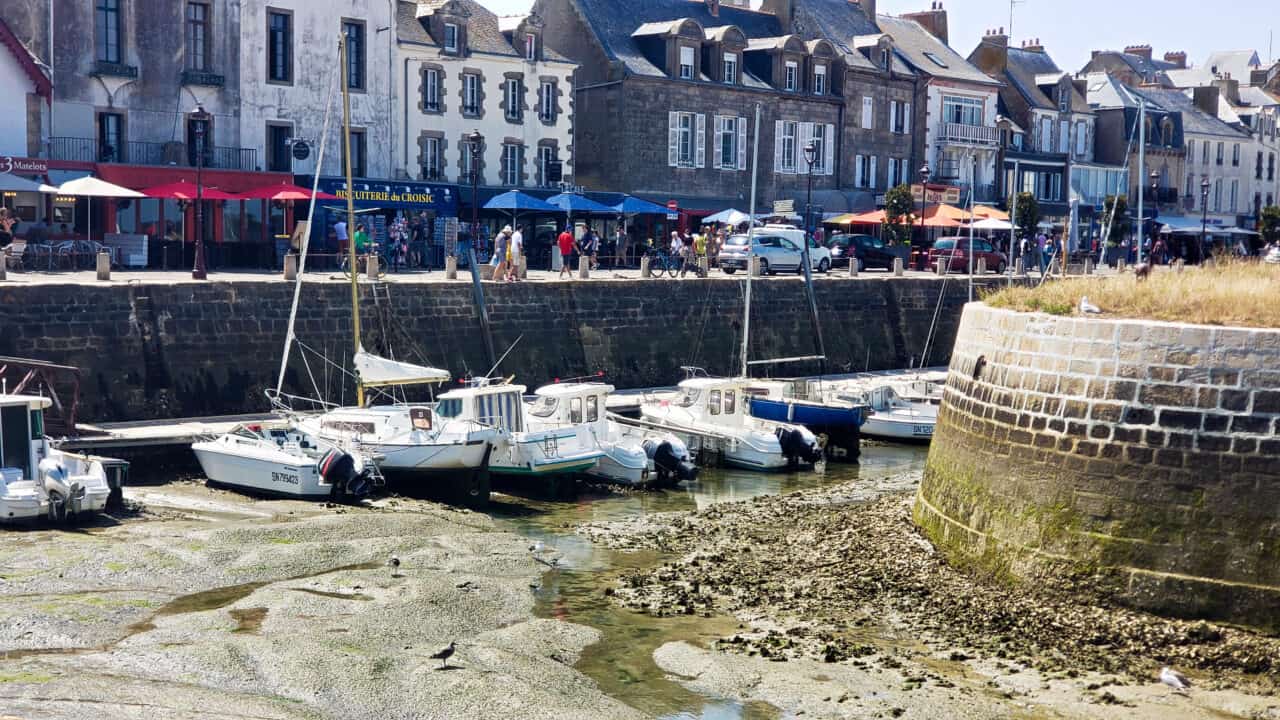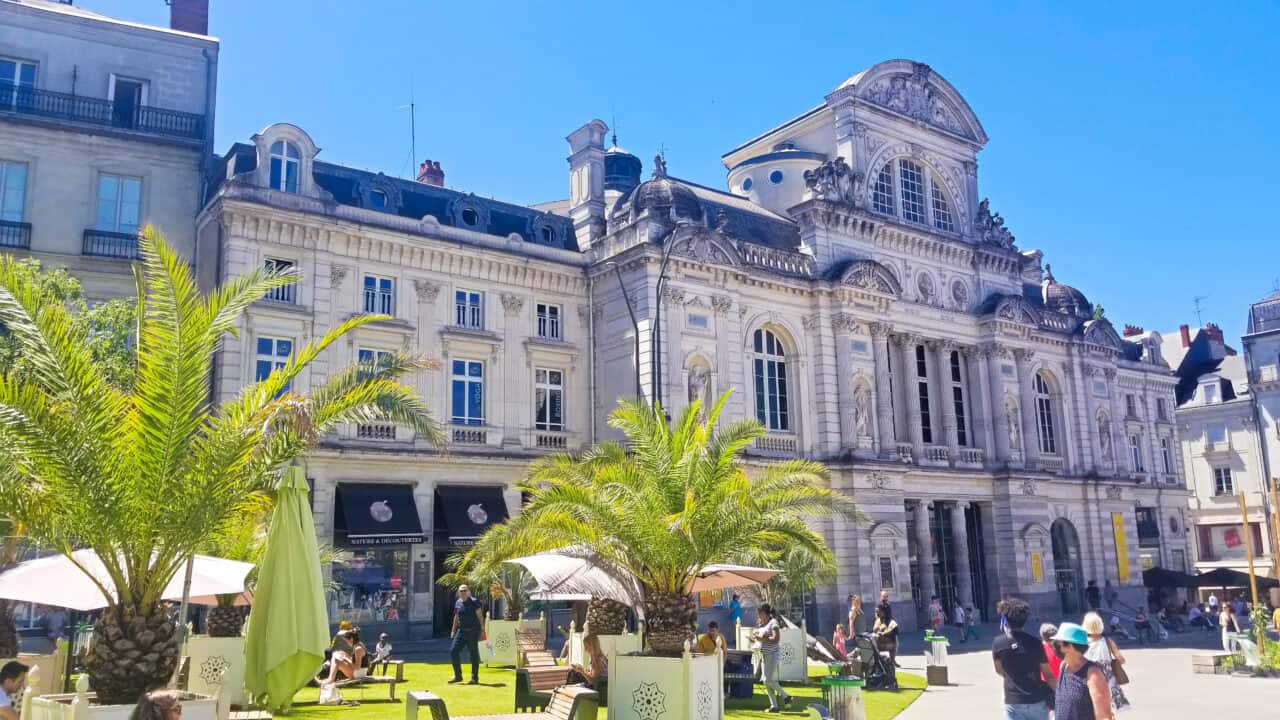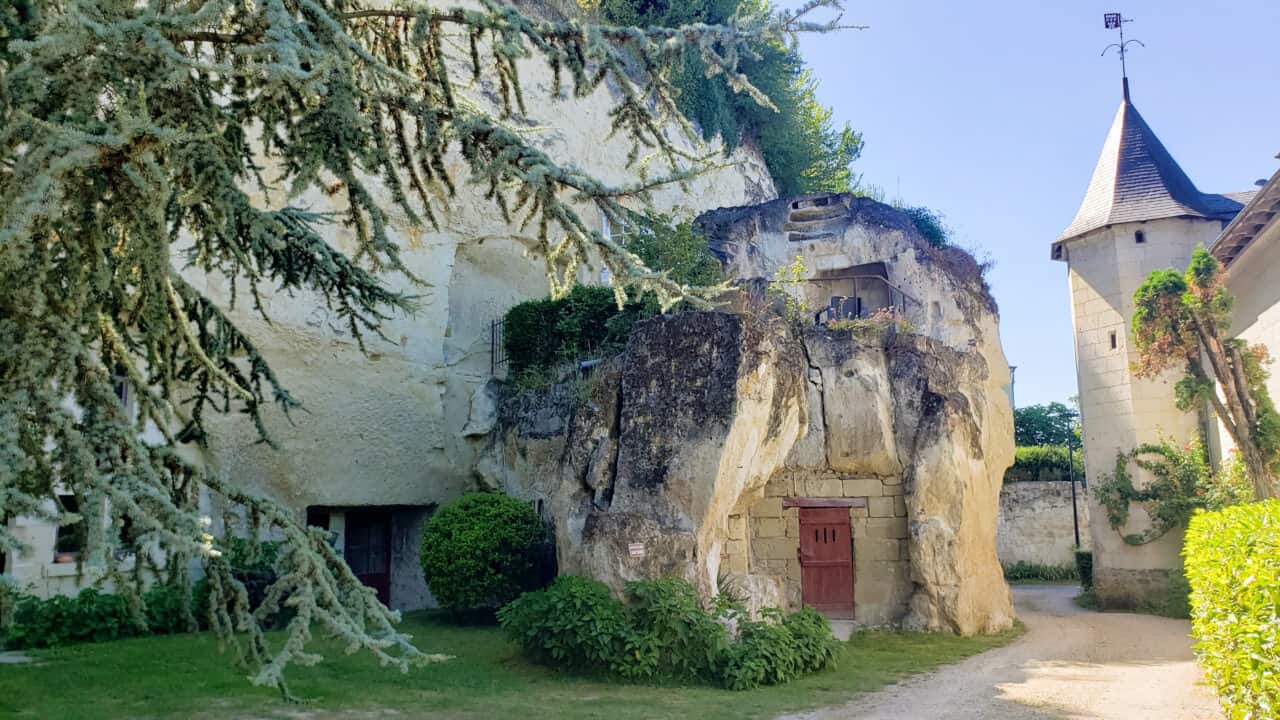Apocalyptic Heat Wave

It was interesting listening to the Canadian CBC news broadcast talk about the apocalyptic heat wave covering France. They were right. This summer is the first time that electrical power has ever been a consideration for us, never mind the deciding factor, in what campgrounds we stayed at.
We spent 3 weeks in the city of Blois. In all that time I never got to see the light show at the chateau. We had been told that it was a great show with headsets and audio matching the changing images on the outside of the various buildings. The history of the area was revealed in lights and sound. The show was about an hour long but didn’t start until 10:30pm. Mike was definitely not keen on going out at that time of night. Oh well.
The good news is that today is cooler at 29°C (84°F) and pouring rain so I finally get to spend some time putting this article together. This week is just a short break before the weather is back up into the mid to high 30s. Electrical power remains important.

Between the cities of Blois and Nantes we spent 6 nights in Angers. We couldn’t stay any longer because the campground was fully booked after that. This is becoming a bit of a problem. Apparently August is when everyone in France takes their holidays and we have to actually book ahead and do a little planning. With that said, our booking ahead is planning for the next area we want to visit one week later. It isn’t like we are planning out our entire summer. None the less, we would still much rather wait until the last minute to decide when we are leaving and where we are going, and then be able to change our mind again the next morning. We have actually just booked into a campground near the medieval town of Concarneau starting a week from now. The problem is that I really have no idea how long I want to be in that area. Trying to extend your stay in prime season can be very difficult. We even tried to extend our stay here in Nantes and were told we couldn’t do that as they were fully booked. This isn’t an issue that we have encountered before in Eastern or Central Europe.
I have to tell you something funny that we heard the other day. We talked for a while with a waitress who informed us that Canada is known in France as a good place to work. Given that France has legislated what we would consider shorter work weeks and longer holidays we were a little surprised and asked for more details. She told us that if an employee did something wrong in Canada the employer would help that person improve and teach them how to do it better the next time instead of always pointing out their errors which happens in France. She was quite insistent that this was a well-known fact about the two countries. As I said, we were a little surprised.

On one excursion we took the car to visit a couple of France’s ”Plus Beaux Villages” that I have mentioned previously. On the way we happened to see a troglodyte (underground living) cave site in La Vignole. People live in these homes. We met one other couple while we were there. They were staying overnight in one of the buildings which I guess must be a small inn. It was just great to see a cliff wall with proper doors and windows built into the rock. I bet that the people living here where quite comfortable during these awful heat waves.
One day we drove out to the Atlantic coast and visited a few seaside towns. Have a look at the picture at the top. Le Croix was a lovely seaside town to wander through but if you want to take your boat out at low tide it looks like you will be disappointed. Some of the boats we saw had supports lowered on both sides to stabilize the boat when the tide was out. How would you like to pay to keep your boat in an area where you could only access it for a few hours each day?
On this same trip we visited the seaside town of Saint-Nazaire. Another waitress told us that this was the last town that the Germans finally abandoned at the end of WWII. She lived in a home built after the war as most of the local homes had been destroyed. The Germans had built a very large submarine base in Saint-Nazaire. In the submarine base the city uses one large concrete room to exhibit a piece of work by a different artist every year. This year the artist basically had a huge amount of sand, presumably shaped with a purpose, although that wasn’t obvious. In the background there was sand constantly pouring down like a wall of water and presumably being brought back up out of view. This contemporary art reminded us of one of the chateaux that we had visited and what they had done to their lovely rooms including the chapel. Mike and I have decided that we really aren’t into most contemporary art.
Now something that we` really appreciated the look of was this “shopping mall” in Nantes. It is called the Passage Pommeraye. It was designed to create a covered link between the business district and the cultural district. Passage Pommeraye was built between 1840 and 1843 with dozens of lawsuits slowing the progress. In addition to the technical difficulties including crossing multiple streets with a drop of 9.4 m (31 ft) there was a lot of hostility from local residents, evicted tenants and more. It sounds very similar to starting a new project today 😊 except they didn’t have to complete an environmental assessment first.

The Passage was an immediate success, however five years later the operation ended in failure due to the economic crisis of 1848. The promoter Pommeraye, who had invested all his property in the development and mortgaged his wife’s considerable inheritance, was ruined and died within two years.
There were major renovations completed in 2015. Looking at the Passage the design around the central staircase is marvellous. It was even better when I found out after we had climbed all the way up the stairs that we could exit at street level from the top without going back down the stairs. The shopping mall has three levels with each level having an entrance on a different street thanks to the steep slope.
Mike and I found the architecture here to be much more interesting than a room filled with sand.
We have met a couple of sets of campers from Scotland recently. I don’t know if anyone reading this has been listening to the news but Scotland’s current First Minister Nicola Sturgeon, has announced that she wants to have another referendum next year on Scottish Independence. This is just one more impact of what Mike and I think as the awful Brexit decision. The first couple were quite quiet and didn’t believe that Scotland should separate for economic reasons. The second couple, who had the Scottish flag (St. Andrews cross) draped over the hood of their camper, were very fiery and very adamant that Scotland would be better on its own rather than being second class citizens and they were going to do anything they could to help make this happen. Throughout our “discussion” with this couple, I felt like we were being told we were wrong and were being yelled at. Given that we hadn’t taken any position on the subject this was a little strange. Meeting people with different viewpoints is what makes the travelling so interesting.
Another item that seems a little strange or at least unusual, is that some of the grocery stores don’t allow their cashiers to take any cash. There is a money machine at each checkout counter where the customer has to insert their own money if they are paying by cash.

Two years ago a huge fire erupted at the Cathedral of St Peter and St Paul in Nantes. The fire broke out in three places (i.e. arson) inside the church. The great organ from the 17th century was destroyed . Due to the heat , the large western stained glass window was blown out . There was huge amounts of damage. The floors and walls inside of the cathedral were severely polluted by the smoke and soot which was contaminated with lead.
In the days and weeks after the fire the working conditions for the responders were really dangerous. They had to put on two suits, a special mask, gloves, and then go through five decontamination airlocks before they could enter the nave of the cathedral. They would work for two and a half hours and then have to come out of the cathedral for half an hour because it would be too dangerous to stay inside.
Two years later you can still see the airlocks and the decontamination tents in front of the cathedral. The building is still closed and they say that every square centimeter inside is covered with lead. Mike says that this would be from the destroyed organ pipes that were all made from lead.
A year after the fire, the man facing criminal charges for torching the cathedral was arresting on charges of killing a French priest.
Mike thinks that I delete far too many of the pictures that we take. I will admit that sometimes I do delete pictures a little quickly. I deleted the pictures that we took of the front of the Cathedral because the construction equipment and the tents were much too prominent. It turns out that those pictures would have gone well with this description.
In addition to the heat waves France has been experiencing a drought as well. From what we have seen the combination of the heat and the dryness has been terrible for the crops. As we ride through rural areas my farming husband keeps looking out at the fields in dismay. Just yesterday he looked at a corn field and said that it would never have any corn and should just be plowed under. It really is too bad.
I must tell you about one building we saw as I wrap-up. In one town, the town hall was flying four different flags. One was obviously the flag of France, one was the EU flag, the third was the Ukrainian flag and the fourth was simply plain white. My only understanding of a plain white banner or flag is that it means we give up or we surrender? I wonder why that was flying over a town hall?



Leave a Reply